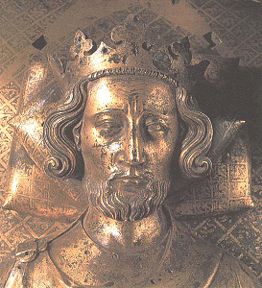King Henry III of England 1 2
- Born: 1 Oct 1207, Winchester Castle, Winchester, (Hampshire), England
- Marriage (1): Eleanor of Provence on 14 Jan 1237 in Canterbury, Kent, England
- Died: 16 Nov 1272, Westminster Palace, London, England at age 65
- Buried: Westminster Abbey, Westminster, London, Middlesex, England
Research Notes:
From Wikipedia - Henry III of England :
Henry III (1 October 1207 - 16 November 1272 ) was the son and successor of John "Lackland" as King of England , reigning for fifty-six years from 1216 to his death. Mediaeval English monarchs did not use numbers after their names, and his contemporaries knew him as Henry of Winchester. He was the first child king in England since the reign of Ethelred the Unready . Despite his long reign, his personal accomplishments were slim and he was a political and military failure. England, however, prospered during his century and his greatest monument is Westminster , which he made the seat of his government and where he expanded the abbey as a shrine to Edward the Confessor .
He assumed the crown under the regency of the popular William Marshal , but the England he inherited had undergone several drastic changes in the reign of his father. He spent much of his reign fighting the barons over the Magna Carta [citation needed ] and the royal rights, and was eventually forced to call the first "parliament " in 1264. He was also unsuccessful on the Continent, where he endeavoured to re-establish English control over Normandy , Anjou , and Aquitaine .
Coronation
Henry III was born in 1207 at Winchester Castle . He was the son of King John and Isabella of Angoulême . After his father's death in 1216, Henry, who was nine at the time, was hastily crowned in Gloucester Cathedral ; he was the first child monarch since the Norman invasion of England in 1066. The coronation was a simple affair, attended by only a handful of noblemen and three bishops. None of his father's executors was present, and in the absence of a crown a simple golden band was placed on the young boy's head, not by the Archbishop of Canterbury (who was at this time supporting Prince Louis of France , the newly-proclaimed king of England) but rather by the Bishop of Gloucester . In 1220, a second coronation was ordered by Pope Honorius III who did not consider that the first had been carried out in accordance with church rites. This occurred on 17 May 1220 in Westminster Abbey .[1]
Under John's rule, the barons had supported an invasion by Prince Louis because they disliked the way that John had ruled the country. However, they quickly saw that the young prince was a safer option. Henry's regents immediately declared their intention to rule by Magna Carta , which they proceeded to do during Henry's minority. Magna Carta was reissued in 1217 as a sign of goodwill to the barons and the country was ruled by regents until 1227...
Death
Henry's reign ended when he died in 1272, after which he was succeeded by his son, Edward I . His body was laid, temporarily, in the tomb of Edward the Confessor while his own sarcophagus was constructed in Westminster Abbey ...
Marriage and children
Married on 14 January 1236 , Canterbury Cathedral , Canterbury , Kent , to Eleanor of Provence , with at least five children born:
Edward I (b. 17 January 1239 - d. 8 July 1307 )
Margaret (b. 29 September 1240 - d. 26 February 1275 ), married King Alexander III of Scotland
Beatrice (b. 25 June 1242 - d. 24 March 1275 ), married to John II, Duke of Brittany
Edmund (16 January 1245 - d. 5 June 1296 )
Katharine (b. 25 November 1253 - d. 3 May 1257 ), deafness was discovered at age 2. [1]
There is reason to doubt the existence of several attributed children of Henry and Eleanor.
Richard (b. after 1247 - d. before 1256 ),
John (b. after 1250 - d. before 1256 ), and
Henry (b. after 1253 - d. young)
Are known only from a 14th century addition made to a manuscript of Flores historiarum , and are nowhere contemporaneously recorded.
William (b. and d. ca. 1258 ) is an error for the nephew of Henry's half-brother, William de Valence .
Another daughter, Matilda, is found only in the Hayles abbey chronicle, alongside such other fictitious children as a son named William for King John , and a bastard son named John for King Edward I . Matilda's existence is doubtful, at best. For further details, see Margaret Howell, The Children of King Henry III and Eleanor of Provence (1992).
Personal details
His Royal Motto was qui non dat quod habet non accipit ille quod optat (He who does not give what he has, does not receive what he wants).
His favorite wine was made with the Loire Valley red wine grape Pineau d'Aunis which Henry first introduced to England in the thirteenth century. [2]
His favourite oath was "By the face of Lucca", referring to the Volto Santo di Lucca .
He built a Royal Palace in the town of Cippenham , Slough , Berkshire named "Cippenham Moat ".
In 1266, Henry III of England granted the Lübeck and Hamburg Hansa a charter for operations in England, which contributed to the emergence of the Hanseatic League .
Noted events in his life were:
• King of England, 1216-1272.
Henry married Eleanor of Provence, daughter of Ramon Berenguer IV Count of Provence and Forcalquier and Beatrice of Savoy, on 14 Jan 1237 in Canterbury, Kent, England. (Eleanor of Provence was born about 1223 and died on 25 Jun 1291 in Amesbury, Wiltshire, England.)
Marriage Notes:
Ancestral Roots has m. 14 Jan 1237 and m. 14 Jan 1236
|
